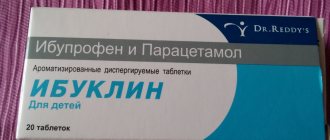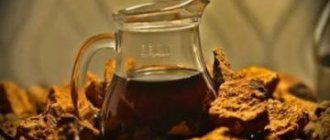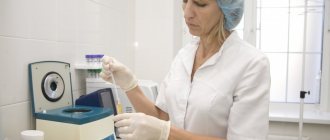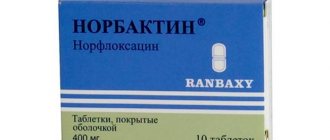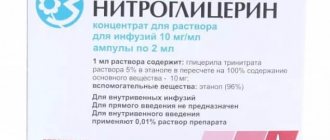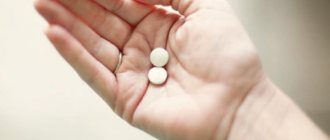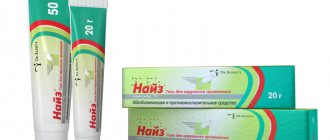Compound
Mustard plasters are paper bags with powdery contents. They can be whole or divided into 4 cells. The powder consists of crushed mustard seeds, to which cake and eucalyptus oil can be added, depending on the form of release. The packages are placed in plastic packaging.
Mustard contains the following substances that provide the medicinal properties of the drug:
- Glycosides . Depending on the type, it can be synagrin (black mustard) or sinalbin (white mustard). Both of these compounds have strong irritant properties. In fact, their effect resembles poisoning only with less pronounced symptoms. They can also be compared to allergens. When glycosides enter the bloodstream, they cause the release of adrenaline, and the entire body comes into a state of “combat readiness.” This increases the activity of phagocytes - cells that are responsible for digesting infectious agents.
- Fatty oil . It contains unsaturated fatty acids, which have a beneficial effect on the skin, as well as phytosterols, which have a bactericidal effect.
- Mirozin . This is an enzyme that breaks down glycosides, thus regulating their amount in the plant. It transforms them into an active state, in which they penetrate the skin. There is anecdotal evidence that it may act as an antiseptic.
- Vitamins and minerals . The plant contains large quantities of potassium, magnesium and phosphorus. Vitamin PP was also found in the seeds. When applied to the skin, they are slightly absorbed without having a significant effect on the body.
About 10% of the seed composition remains unidentified.
Attention! Mustard powder should be used only topically and as directed! Possible serious poisoning if ingested or inhaled.
Breathe steam
For some diseases, doctors often prescribe inhalation - inhalation of medicinal substances. This procedure is easy to do yourself.
Heat the water in a saucepan to a boil, add a few drops (5–10 per half glass of water) of easily evaporating medicines, such as menthol or eucalyptus oil. Roll up a large funnel from thick paper and cover the pan.
Sit in front of the pan (at a distance of 20–40 cm), put the narrow end of the funnel to your mouth and inhale the steam. If you don’t have thick paper, cover yourself over the pan with a towel, sheet, or warm scarf.
Indications for use
Mustard plasters can be used in the following cases:
human respiratory system
Infections of the upper and lower respiratory tract. These include bronchitis, sinusitis, tonsillitis, pharyngitis, pneumonia. Mustard plasters help well with dry coughs (when separating sputum, they should be used only with the permission of the attending physician).
- Pain in muscles and joints caused by sprains, bruises, osteochondrosis, etc.
- Cardialgia (pain in the heart area).
- Sciatica. This is a disease associated with pain in the lower back and leg, sensations of cold or heat.
Mustard plasters for high blood pressure, where to put them?
Traditional medicine does not give up its position in the fight against various ailments. Sometimes doctors themselves give recommendations on the use of natural medicines in one form or another.
They can be used for mild illness or in combination with prescribed medications.
Natural medicines can be used in the form of tea, lotions, compresses, inhalations, anti-inflammatory and disinfectant washes, as vitamins, analgesics, antipyretics, or those affecting the functioning of the cardiovascular system.
In pharmacies you can find herbal tinctures, dried herbs, flowers, berries, packaged and ready to eat.
One of these drugs is mustard plasters. Since one of the components in them is mustard seeds ground into powder.
Method of use
The mustard plaster is shaken off to evenly distribute the powder inside the bag. Before use, it is important to check the integrity of the packaging, otherwise burns may occur. The bag is immersed for a few seconds in water heated to 37°. After this, the liquid is allowed to drain and placed on the patient’s clean, dry skin.
It is advisable to wrap polyethylene and insulating material on top, at least a wool scarf. For children, the procedure time should be several minutes, for adult patients – up to 20. It is necessary that the mustard plaster be pressed tightly to the skin. The tension should only be released when a strong burning or itching sensation occurs. Keeping mustard plaster longer than the specified period can be hazardous to health.
Attention! Only the correct use of mustard plasters and their placement according to the instructions will save patients from possible undesirable consequences.
After the procedure, you need to avoid physical or mental stress and hypothermia. A better solution would be to go to bed or engage in quiet activities.
Overlap zones
Most often, mustard plasters are placed on the back and chest area. Indications for this are inflammation of the lower respiratory tract. On the back, they are placed under the shoulder blades to the lumbar area, without affecting the spine area. In front they are placed on the sternum and ribs. This measure is most often practiced for bronchitis. It is worth noting that it is unlikely that it will be possible to warm up the respiratory tract with the help of mustard plasters; their effect does not extend so deeply. Inhalation is more suitable for these purposes.
For a runny nose, mustard plasters can be used as a measure of distraction therapy. To do this, they are put on their feet. For any colds, it is recommended to apply mustard plasters to the calves or feet.
Important! It is better not to put mustard plasters on your face because of the risk of getting burns; for these purposes it is better to use a pepper plaster.
For radiculitis, they are placed on the lower back . Experts recommend first dipping them in a solution of honey with furatsilin. This will enhance the warming effect and reduce the manifestation of inflammation.
For osteochondrosis, mustard plasters are placed on the site of the lesion, trying to place them on the muscles . For the cervical variant of the disease, they are placed on the collar area. In this case, mustard plasters do not help get rid of osteochondrosis. They are a temporary measure to reduce the severity of symptoms.
In traditional medicine manuals you can find recommendations for treating headaches, hypertension, and insomnia with mustard plasters. This measure is not official and is not reflected in the instructions. To do this, mustard plasters are placed on the area of the feet or on the back of the head. In the latter case, they need to be squeezed out less: this is necessary so that the active components reach the scalp through the liquid that wets the hair.
Video: why and how to install mustard plasters?
Placement of mustard plasters in the chest area
To treat respiratory infections, as well as to prevent colds, warming procedures using mustard plasters are often used.
Previously, this method was especially popular among the population, but with the advent of drugs they began to forget about it. And this is in vain, since this method of treatment is much more effective and affordable.
But in order to use it, you first need to find out how to place mustard plasters correctly and for what diseases they are indicated.
Places for placing mustard cards
This product is used for placement on the chest, back (just above the shoulder blades), back of the head, heart area and calf muscles. Yellow cards can also be placed on other parts of the body, but only as prescribed by a doctor.
Safety precautions when using mustard plasters:
- If this remedy is indicated for the treatment of cough or other diseases, then during the procedures it is necessary to carefully ensure that essential oils do not get on the mucous membranes. To do this, the patient is recommended to close his eyes and turn his head to the side.
- To avoid complications, it is necessary to strictly adhere to the time for placing mustard plasters (no more than 10 minutes for an adult and 2-5 minutes for a child).
- During the warming procedure using mustard cards, the patient's condition should be carefully monitored.
Necessary equipment
Before the procedures, you should ensure that you have the following attributes:
- tray with water (liquid temperature should be approximately 40-45⁰С);
- mustard cards;
- water thermometer;
- 2 towels (for through events);
- napkins;
- warm blanket;
- watch.
Instructions for use
In order to give a general idea of how to correctly place mustard plasters on a patient, we will describe the strict sequence of necessary actions:
- Completely eliminate drafts in the room.
- Check the suitability of the product (dry mustard should not spill out and have a specific smell).
- Pour warm water into the bowl.
- Expose the patient's desired area of the body.
- Dip the mustard plaster into the liquid, let it sit for a few seconds, then remove and shake.
- Place the card tightly against the skin (the side where there is powder), cover with a towel, and then with a blanket.
- After a couple of minutes, find out how the patient is feeling (he should feel a slight burning sensation and warmth). After this, you should lift the mustard plaster and determine the degree of hyperemia of the skin. If it is pronounced, it is better to remove the product, otherwise leave it for another 5-10 minutes, taking into account the individual sensitivity of the patient.
- Remove mustard plasters.
- Moisten a napkin in warm water, wipe the patient's skin with it and wipe dry with a towel.
- Make sure that the patient puts on underwear, and then cover him with a blanket for 30 minutes.
- On this day, the patient should not take a shower or bath.
Indications
You can use the presented tool when:
- bronchitis;
- ARVI;
- pneumonia;
- neuralgia;
- lumboischialgia;
- myalgia;
- arthralgia;
- osteochondrosis;
- soft tissue bruise;
- sprains;
- cardialgia.
When is it prohibited to install mustard plasters?
This product should not be used if:
- hypersensitivity;
- pyoderma;
- pregnancy;
- breastfeeding;
- violation of the integrity of the skin;
- diffuse neurodermatitis;
- atopic dermatitis;
- for psoriasis;
- eczema.
Also, many people are often concerned about the question of whether it is possible to install mustard plasters at a temperature? Experts note that for diseases that occur with high fever, the use of this remedy is strictly prohibited.
Mechanism of action
When the glycoside comes into contact with the skin, an irritation reaction occurs. The body reacts to mustard components as if it were a foreign agent. As a result, the blood vessels dilate at the site of application and immune system cells migrate there. Redness develops, burning and itching is felt.
The hormone adrenaline is released into the blood. It stimulates all body systems, including the immune system. As a result, special cells - phagocytes - are activated. They are responsible for digesting foreign elements. In case of infection, this helps fight its sources. In case of muscle pain, increased local blood circulation helps to quickly remove harmful toxins, in particular lactic acid.
Distraction therapy for hypertension and headaches is associated with the idea that when the intensity of blood circulation increases in one place, it decreases in another. That is, applying mustard plasters to the feet should cause blood to flow out of the head, which will lead to the elimination of symptoms. It must be said that this theory does not find any confirmation in theoretical medicine.
Contraindications
Mustard plasters have a wide range of contraindications. They can be relative or absolute. They should absolutely not be used in the following cases:
- Damage to the skin. These include both direct violation of integrity (wounds, scratches), and irritation as a result of dermatitis, allergies, burns, etc.
- Body temperature is above 37°. In this case, you should not carry out additional warming in any way; this, firstly, will not bring the desired result, and, secondly, it will cause unnecessary stress for the body.
- Purulent-inflammatory process. An increase in temperature can activate the body's defense reactions. This means that the formation of pus and other symptoms will intensify.
- Intolerance to the components of the drug. If the use of mustard plasters, while observing safety precautions, led to allergies, blisters, persistent redness, severe irritation or itching, it is better to choose other means for treatment.
Other contraindications are not clear and categorical ; if they exist, mustard plasters should be used after consulting with a doctor and discussing the treatment regimen:
- Pregnancy. In an interesting position, heating is undesirable, since it can provoke an increase in the tone of the uterus and cause miscarriage. Applying them to the shoulders and neck can be considered relatively safe.
- Lactation. It is not recommended to put mustard plasters on the chest; the method has no other contraindications.
- Oncological disease. Warming is contraindicated for those who have neoplasms and those who have already gotten rid of them. It is believed that an increase in temperature can trigger tumor growth. However, if its localization has nothing to do with the place of heating, the doctor may allow the procedure to be performed.
- Childhood. The manufacturer does not impose any age restrictions, but it is better not to use them for persons under 2 years of age. Since a small child cannot clearly communicate his feelings, there is a risk of burns that an adult may not immediately notice.
- Predisposition to allergies. Before using mustard plasters, you need to check how the body will react to this type of treatment. Mustard essential oils are quite strong allergens. To do this, a weak solution of mustard powder should be applied to 1 square cm of sensitive skin (for example, the inner surface of the elbow). Mild itching and tingling are normal; if blisters appear, it is necessary to lubricate the area with fenistil or other antiallergic ointment.
- Thin sensitive skin. In this case, you must also check your reaction to mustard. It is better not to place compresses directly on the skin, but to use a layer in the form of a napkin or gauze.
Algorithm and technique for setting mustard plasters
Algorithm for setting mustard plasters
Equipment:
- Mustard plasters.
- Tray for used material.
- Waterproof bag or container for Class B waste disposal.
Preparation for the procedure:
- Identify the patient, introduce yourself, explain the purpose and course of the upcoming procedure. Make sure you are not allergic to mustard. If you have an allergy and do not consent to the procedure, check with your doctor about further actions.
- Treat hands hygienically and dry.
- Wear gloves.
- Examine the patient's skin for damage, pustules, and rashes to determine indications for the procedure.
- Check the suitability of mustard plasters: mustard should not fall off the paper and have a specific (pungent) smell. When using mustard plasters made using other technologies (for example, packaged mustard), check the expiration date.
- Prepare equipment. Pour hot (40° - 45°) water into the tray.
- Help the patient lie on his stomach (when placing mustard plasters on his back) and take a comfortable position, the patient's head should be turned to the side.
Technique for performing the procedure:
- immerse the mustard plaster in hot water and let it drain;
- apply the mustard plaster tightly to the skin with the side covered with mustard;
- repeat the steps, placing the required number of mustard plasters on the skin;
- cover the patient with a diaper, then a blanket;
- clarify the patient’s sensations and the degree of hyperemia after 3 - 5 minutes;
- leave the mustard plasters for 10 - 15 minutes, taking into account the patient’s individual sensitivity to mustard.
The technique of installing mustard plasters implies knowledge of the places of their application:
- interscapular and subscapular region;
- anterior and lateral surface of the chest;
- lower legs and feet;
- occipital region of the head;
- area of the cervical spine.
End of the procedure:
- If persistent hyperemia appears (after 10-15 minutes), remove the mustard plasters and place them in a prepared tray for used materials with their subsequent disposal.
- Soak a napkin in warm water and remove any remaining mustard from the skin.
- Use a diaper to blot the patient's skin dry.
- Help him put on his underwear, cover him with a blanket and warn him to stay in bed for at least 20 to 30 minutes and not take a bath or shower that day.
- Remove gloves.
- Treat hands hygienically and dry.
- Check with the patient how he is feeling.
- Make an appropriate entry about the procedure performed in the medical documentation.
Indications for nursing manipulation “Putting mustard plasters”
Hypertensive crisis, angina pectoris, myocardial infarction, bronchitis, pneumonia, intercostal neuralgia, myositis.
Contraindications for use
It is important to know those conditions in which the installation of mustard plasters is contraindicated:
- disorders of skin sensitivity;
- pulmonary hemorrhage;
- diseases and damage to the skin in this area;
- increased body temperature;
- malignant neoplasms;
- blood diseases;
- bronchial asthma.
What is important to consider when performing nursing manipulation:
- It is necessary to monitor the time of the procedure, since with longer exposure to mustard plasters, a chemical burn of the skin with the formation of blisters is possible.
- In case of severe burning or increased sensitivity of the skin, mustard plasters are applied through thin paper or cloth.
- Material tested by Aktion Medicine experts
Source: https://www.zdrav.ru/articles/4293658049-17-m12-08-postanovka-gorchichnikov
Side effects
After taking mustard plasters, the following unpleasant consequences are possible:
- Burns. Glycosides may cause chemical damage to the skin. If there is severe burning and pain, their use should be stopped immediately.
burn from mustard plasters
Allergy. In addition to local irritation, urticaria and redness outside the mustard plaster may appear. Sometimes essential oils cause allergies when inhaled. Then the reaction will be cough, lacrimation, and rhinitis.
- Activation of the inflammatory process. By stimulating the immune system, mustard plasters cause pronounced symptoms of inflammation. In this case, the patient's condition may worsen, which is not always desirable.
General information
Both mustard plasters and medical cupping are non-drug treatment methods that are used as an auxiliary therapy for diseases of the lungs and bronchi.
Each person should clearly understand that these methods cannot be the main treatment. The effect of mustard plaster occurs at the reflex level. If a person is given medical cupping, then their effect is comparable to autohemotherapy . Opinions are currently divided regarding the use of these methods. Some people argue that these methods of treatment are outdated and there is no point in using them. But many still use them, sincerely considering both cups and mustard plasters to be effective methods to alleviate the condition of lung diseases. However, it is necessary to clearly know when mustard plasters can be placed in adults, since there are clear indications and contraindications for the use of both mustard plasters and medical cups. They will be discussed in this article.
Patient reviews
In terms of effectiveness for colds and muscle pain, mustard plasters are rated highly. Patients note the following advantages:
- Low price and availability (mustard plasters are available in almost any pharmacy).
- A noticeable improvement in well-being and a reduction in the period of illness.
- Mustard plasters are a natural remedy that does not have a negative effect on the body.
- After warming up in this way, sleep improves.
The disadvantages of the product are the following:
- By neglecting safety rules and intending to “endure” severe pain, some buyers received burns, up to the second degree.
- Inconvenient to use. It is quite difficult to put mustard plasters on yourself; someone’s help is needed.
- Children don't like mustard plasters. In any case, the procedure can hardly be called pleasant, so persuading a child to undergo it is not at all easy.
- Marriage occurs. Poor packaging can cause mustard to “leak” through the pores in the bag. This can cause burns or make the procedure completely impossible.
The use of mustard plasters is safe if the described technique is followed. Their effectiveness is a controversial issue. However, it’s definitely worth trying to apply packages in order to evaluate the effect of mustard plasters.
What can be replaced?
Among the folk remedies for treating cough, you can find similar methods of treatment, without the use of burning compresses:
- Pour dry mustard powder into socks. Remove them after 15–20 minutes.
- Use heated jars. However, keep in mind that after using them, marks remain on the body.
- Foot baths based on dry mustard. Mix 50 grams of the substance with warm water. Keep your feet in the basin for 20 minutes.
Burning compresses are considered an effective remedy for treating coughs. However, it is necessary to take into account the active effect of mustard plasters in order to avoid burns or other complications.


